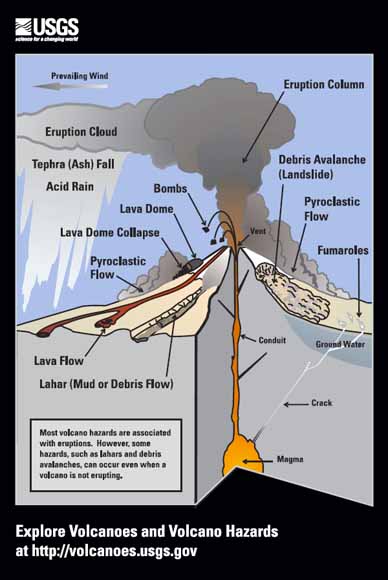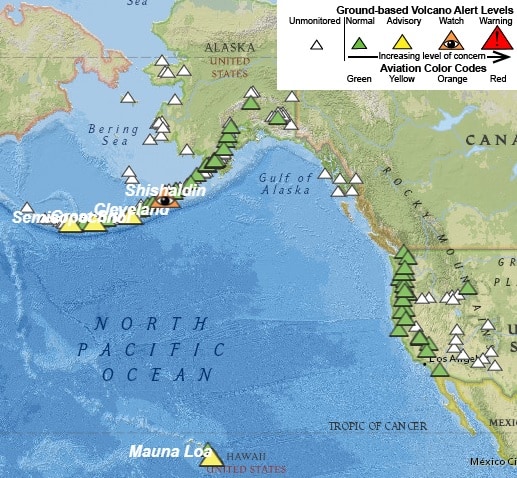Volcano FAQs: Types of Volcanoes, Ring of Fire, & More

What is a Volcano?
 A volcano is an opening in the Earth’s crust where magma comes to the surface and is expelled as lava. An eruption can be violent and explosive (like Mount Saint Helens in Washington State) or slow and steady (like Kīlauea on the big island of Hawaii).
A volcano is an opening in the Earth’s crust where magma comes to the surface and is expelled as lava. An eruption can be violent and explosive (like Mount Saint Helens in Washington State) or slow and steady (like Kīlauea on the big island of Hawaii).
Volcanoes can be either active, dormant, or extinct. Active volcanoes are those that are currently erupting or are expected to have an eruption in the near future. Dormant volcanoes are volcanoes that haven’t erupted in a long while but may erupt at some point again in the future. Lastly, extinct volcanoes are those that no longer have a full magma chamber beneath them and are unlikely to erupt again.
What are the Different Types of Volcanoes?
Did you know that there are many different types of volcanoes? In general, there are four types of volcanoes: cinder cone volcanoes, composite volcanoes, shield volcanoes, and lava domes.
- Cinder Cone Volcanoes: These volcanoes are the most common form of volcano and are the cone-shaped volcano people typically think of. Lava is spewed through a single vent at the top of the cone, forming a crater at the summit.
- Composite Volcanoes: Also known as stratovolcanoes, composite volcanoes have multiple vents that can spew gasses and lava. They typically result in violent eruptions as well as pyroclastic flows, debris-flow avalanches, and lahars.
- Shield Volcanoes: These volcanoes are shaped like broad shields and don’t necessarily have a cone-shaped peak like other types of volcanoes have. These eruptions tend not to be as violent as other volcanoes but more frequent.
- Lava Domes: Lava domes are typically smaller and rounder bulbous masses of lava. Before they erupt, they tend to grow higher and wider until the pressure is too much and the lava dome explains.
What is the Ring of Fire?
The Ring of Fire (also called the Circum-Pacific Belt) is a semi-circular path stretching around 25,000 miles around the Pacific Ocean. According to National Geographic, 75 percent of Earth’s volcanoes are located on the Ring of Fire and 90 percent of earthquakes occur in this area. The Ring of Fire is caused by the meeting of tectonic plates that cause subduction zones.
Consider purchasing the following items to ensure your family’s safety during a volcano disaster:
This is an emergency radio that is essential for any emergency or disaster. It can be recharged through its solar panel, hand turbine power generator, or built-in rechargeable battery.
This is a document and valuables safe with a waterproof and fire-resistant design for long-lasting use. It features a privacy key lock to keep items safe from prying eyes.
This is a Type II safety can that can hold up to 2 gallons of liquid oil. It is colored green and made of galvanized steel, with a height of 13.25 inches and an outside diameter of 9.5 inches.
Where is the Ring of Fire in the United States?
The United States Geological Survey (USGS) has a map that shows the volcanoes along the Ring of Fire and the level of concern regarding whether they may erupt.
For the most part, there is very little risk of any volcano in the US erupting. If you’re concerned about volcanic activity in your area or the US as a whole, consider signing up for the Volcano Notification Service (VNS) which will alert you to any volcanic activity via email.
The current volcanoes that are in the “very high threat” category (or the most likely to erupt) include Kilauea (HI), Mount St. Helens (WA), Mount Rainier (WA), Redoubt Volcano (AK), Mount Shasta (CA), and Mount Hood (OR). Remember though that there is only a very low chance of any of those volcanoes erupting so there is no need to panic — just be sure to be prepared.
What is a Subduction Zone?
 Tectonic plates are those slabs of mantle and crust that, in their epochs-long drift, rearrange the earth’s continents and oceans. Most of the time their movement is slow, harmless, and all but undetectable. Occasionally however, at the borders where they meet, it is not.
Tectonic plates are those slabs of mantle and crust that, in their epochs-long drift, rearrange the earth’s continents and oceans. Most of the time their movement is slow, harmless, and all but undetectable. Occasionally however, at the borders where they meet, it is not.
In a subduction zone, one tectonic plate bends and slides beneath another, returning back into Earth’s mantle (the hotter layer beneath the crust). The biggest danger of a subduction zone is that they can cause massive, catastrophic earthquakes. They can also cause volcanic activity.
What are Volcanic Hazards?
When people think of volcanoes, they tend to think of the explosive lava raining down from the sky and causing fires and chaos. However, there are many more hazards that can occur in the wake of a volcanic eruption.
- Ballistic Projectiles: What goes up must come down… Volcanic eruptions launch tons of debris into the air from baseball-sized stones to boulders. These can be launched for miles into the surrounding area and can cause significant damage once they come plummeting down to Earth again.
- Debris-Flow Avalanches: Because volcanic eruptions can cause earthquakes, sometimes they also cause avalanches as well. Debris-flow avalanches occur when a landslide is coupled with a volcanic eruption, resulting in a huge amount of dirt and debris to rush down the side of the mountain that destroys everything in its path. The most notable case of a debris-flow avalanche is the eruption of Mount Saint Helens in 1980.
- Lahars: A lahar is a flow of fluids as well as various sizes of rocks and other debris. It typically has the consistency of wet concrete and can destroy towns and villages in their wake, encasing them in the concrete-like mixture. Lahars typically form when a volcano erupts on a snow-covered mountain — the perfect mixture of water and eruption debris to form these deadly mudslides.
- Lava Flows: As mentioned before, these are the most commonly thought of danger when someone mentions a volcano. However, lava flows in general tend to be slow-moving and not the most imminent threat during a volcanic eruption.
- Tsunamis: If a volcano erupts under or near a body of water, it’s possible that a tsunami can form due to the displacement of land. Additionally if a landslide occurs and crashes into the water below, a tsunami may be formed that way.
- Pyroclastic Flows: These flows are a mixture of hot rock and gases that flow downward with the force of gravity, swallowing up anything in their path. Pyroclastic flows kill and destroy by suffocation, crushing impacts, incineration, and burying people alive. One of the most famous examples of a pyroclastic flow is the eruption of Mount Vesuvius and the ensuing destruction of Pompeii.
- Volcanic Gasses: A lesser-known danger of a volcanic eruption is the release of gasses that can choke the life out of the surrounding area and result in acid rain. Carbon dioxide is one of the most nefarious killers, flowing downhill and suffocating anything in its path.
What are the Deadliest Volcanic Eruptions in History?
There have been hundreds if not thousands of volcanic eruptions throughout human history. However, only some of them have caused massive death tolls with most of those coming from the pre-industrial era. Nowadays, geologists can monitor seismic activity and have an idea of when a volcano may erupt. Back then however, there was no such early warning system and the death tolls show it.
| Volcano | Location | Year | Death Toll | Other Impacts |
|---|---|---|---|---|
| Mount Tambora | Indonesia | 1815 | 70,000 - 250,000 deaths | "Year Without a Summer" and overall famines |
| Krakatoa | Indonesia | 1883 | 36,000 deaths | Worldwide drop in temperatures |
| Mount Pelée | Martinique | 1902 | 30,000 deaths | Famine, starvation, disease, tsunamis |
| Nevado del Ruiz | Colombia | 1985 | 23,000 deaths | Mudslides, lahars |
| Mount Unzen | Japan | 1792 | 15,000 deaths | Earthquakes, landslides, tsunamis |



